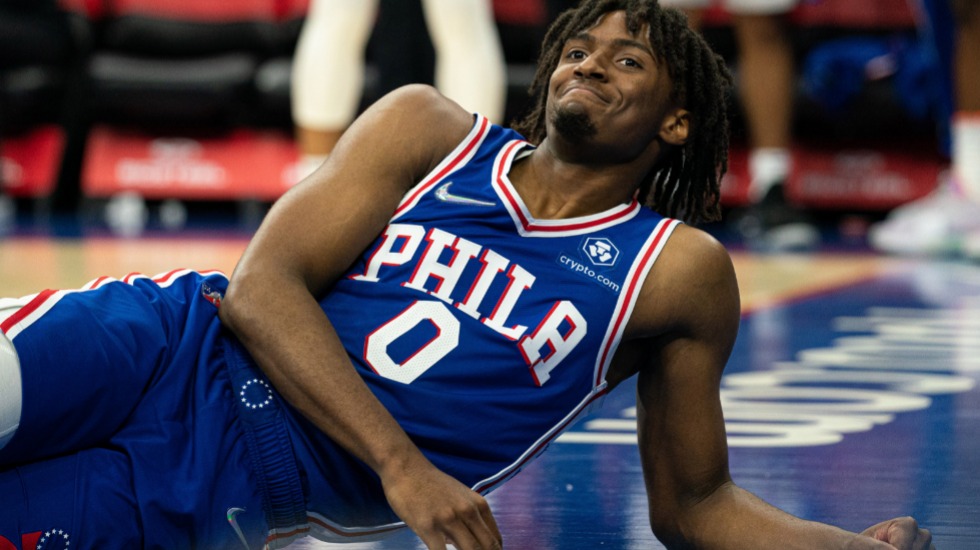In his second year with the Philadelphia 76ers, Tyrese Maxey has been scoring far more efficiently than last season. Photo: USA Today
Last week, this writer unveiled his first NBA “Rookie Rankings” of the season. Early in that piece was the line: “this year’s class of freshmen is a hell of a lot more fun to write about than last year’s batch”.
That’s not entirely fair to last season’s rookies. Headlined by LaMelo Ball and Anthony Edwards, the 2021 rookie class holds some fine top-end talent; it just doesn’t have the depth of the 2020 crop. So let’s give that class its due and take a look at some of the NBA sophomores that have taken a leap this campaign.
Right off the bat, we’re not going to be examining Edwards, Ball or Kings guard Tyrese Haliburton on this occasion. They’re outstanding players, for sure, but they made their bones as rookies. They’re already on their way to stardom, if they’re not there already. This piece is about the second-year men that have made somewhat of a leap early this season.
Tyrese Maxey – Philadelphia 76ers
As a rookie, Maxey came pretty much as advertised: an undersized, occasionally explosive but inefficient scoring guard, ideally suited to the ‘microwave’ role off the bench. He gave the Sixers eight points and a pair of assists off the bench, with shooting a decent 46 per cent from the field, though a decidedly poor 30.1 per cent from range.
This season, the Sixers’ litany of line-up absences have been well documented (they literally had to start five substitutes against Sacramento last week. Philly still won because … KANGZ!!!) but rather than sulk or use it as an excuse, the 10-9 Sixers are keeping their heads above water, largely due to the play of their new starting point guard.
As well as a sharp increase in opportunities (35 minutes per game, up from 15), Maxey has been scoring far more efficiently than last season. His shooting from the field is up to an even 50 per cent at the time of writing. Most importantly, given the amount of times defenders ducked under the screen on Maxey last season, he’s canning his threes at a very solid 38.7 per cent on 3.3 attempts per game.
That improved outside shooting is opening up Maxey’s cunning drive-and-finish game. Maxey’s speed is borderline elite and when combined with his crafty handles and ability to finish with either hand, you have an excellent scoring guard.
Undoubtedly the most important weapon in Maxey’s arsenal is his floater. Able to stop on a dime and finish with both hands, Maxey is the most efficient volume shooter from floater range in the entire NBA at 58.7 per cent, per Second Spectrum.
For all the talk of the Sixers needing a CJ McCollum type to replace Ben Simmons, it looks increasingly like they already have that man in uniform.
Obi Toppin – New York Knicks
As an older rookie, Toppin was expected to contribute immediately to the Knicks last season. Instead, he struggled mightily, averaging just a tick over four points and two boards in just 11 minutes a night.
Perhaps the biggest reason for Toppin’s struggles was the role assigned to him by coach Tom Thibodeau whose proclivity for rim-protecting big men saw Toppin miscast as a stretch four.
Whilst he shot a decent 30.6 per cent from deep, it took away his biggest strength: rim running. Toppin’s speed is elite for a big man and there is barely a basketballer alive that he can’t jump over. Using him as a floor spacer is an almost criminal waste.
This season, Toppin is back to playing as a genuine pick-and-roll five man, and he’s thriving. His minutes have just barely gone up to 15.3 per game, but he’s doubled his scoring to 8.1 per night, as well as blocking 0.8 shots per game, up from a measly 0.2. His chemistry with veteran point guard Derrick Rose is evident in his high two-point percentage (12th in the NBA) and his points from pick and rolls (second in the league).
Playing as a five man also hides Toppin’s weaknesses. He’s a poor ball handler and a limited (though improving) reader of the game. His shooting – never a strength – has cratered with Toppin hitting just six of his 29 attempts from deep so far this season.
Defensively, he’s very upright in his stance and as a result gets repeatedly burned on the perimeter, despite his straight-line speed. As a centre, he’s closer to the basket where he can use his explosiveness to protect the rim and clean up misses.
Desmond Bane – Memphis Grizzlies
Even as the pick was announced, Desmond Bane falling to Memphis at pick 30 was high larceny. The smooth-moving, sharpshooting guard was perhaps penalised for being one of the older players in the 2020 draft and therefore perceived as not having the upside of an RJ Hampton, Josh Green or Malachi Flynn. As Bane has proven, sometimes you just have to go with the best player.
As a rookie, Bane was a very good floor spacer for Ja Morant and Dillon Brooks, putting up 9.2 points whilst shooting a blistering 43.2 per cent from beyond the arc, predominantly coming off the bench.
PLEASE HELP US CONTINUE TO THRIVE BY BECOMING AN OFFICIAL FOOTYOLOGY PATRON. JUST CLICK THIS LINK.
This season, with Brooks injured at the beginning of the campaign, Bane has assumed the starting role and thrived. In 29 minutes (he averaged 22.3 last season) he’s upped his scoring to 15.8 points per contest, third on the team behind Morant and the since-returned Brooks.
Bane has managed to marry that increased production to solid efficiency. He’s shooting from the floor is just about identical to last season and though his success rate from three has fallen to a still very good 37.8 per cent, he’s doing it against increased volume and a more difficult shot profile. He’s also become automatic from the charity stripe, connecting on 91.7 per cent of his attempts.
Bane also brings it at the other end of the court, using his stout frame and high basketball IQ to match up against the opposition’s best guard. With Brooks back in the line-up, he’s even found himself matched up against elite wings in Paul George and LeBron James, despite giving away significant height and weight.
Bane isn’t elite at that end of the floor, by any means, but he battles and makes sure that he doesn’t get badly beaten. On a team that can be flimsy defensively, that matters. Bane is very much in charge.
Cole Anthony – Orlando Magic
As a rookie, Cole Anthony performed exactly as this writer thought he would. The son of long-time NBA point guard and now broadcaster Greg, Cole was the polar opposite to his father’s steady, dour lead guard play: a flashy, exuberant, exciting and wildly erratic scoring guard.
The 15th pick in 2020 gave the Magic 12.9 points, 4.7 rebounds and 4.1 assists in his 27 minutes but he did it whilst shooting sub 40 per cent from the floor. He was fun to watch in the same way that watching a stunt biker is: he could pull off the miraculous; he could go down in flames.
This season, Anthony has changed his style and it’s clearly working. Long known as a player that would pound the air out of the ball, Anthony has benefitted from the arrival of rookies in Jalen Suggs and Franz Wagner that are willing and able ball movers, as well as the continued integration of Wendell Carter Jr, himself a solid playmaker.
That shift utilises Anthony’s blazing speed and shot making by coming off of screens attacking a shifting defence. He’s putting up 19.6 points per game alongside 6.8 boards, 5.9 assists and a steal. Luka Doncic and Ja Morant are the only players in the NBA aged under 25 that are putting up 20/5/5 a night – Anthony is just a whisker away from joining them.
He has quickly become the Magic’s bellwether. With the second-year man on the floor, the Magic’s offence is an astounding 30 points better off per 100 possessions, according to Basketball Reference. That bleeds into the defensive numbers as well, where Orlando is 9.2 points better per 100 possessions.
Rookie head coach Jamahl Mosely has simplified Anthony’s game and his team is reaping the benefits.
Deni Avdija – Washington Wizards
Prior to the 2020 NBA draft, the Israeli forward was seen as an almost certain top-five pick. When he slipped to the Wizards at pick nine, he was viewed as a steal, despite the obvious positional overlap with their 2019 lottery pick Rui Hachimura.
As a rookie, Avdija disappointed somewhat. He was seen as a genuine do-it-all type, though what eventuated couldn’t even be termed “jack of all trades”. Avdija’s shooting was poor (42/32/64 splits), his playmaking slow and predictable, his athleticism less than advertised and his defence average at best. The outlines of a player were there, but you were left unsure as to what the best version of Avdija would look like.
As we’re starting to find out this season, the ultimate Avdija might be a switch-everything-defensive stopper. After being regularly targeted in the pick and roll as a rook, the 20-year-old is now given assignments of players ranging from speedy guards like Morant, powerhouses in James Harden, rangy wings in Brandon Ingram and bigs like Jaren Jackson Jr. He’s also the Wizards’ go-to man to try to slow supernovas like Kevin Durant and Giannis Antetokounmpo.
Avdija has always had elite size and strength on the wing and he’s also improved his quickness. Most importantly, the game looks to have slowed down for him. His defensive reads both on and off the ball have advanced hugely from last season.
As well as putting up 8.8 rebounds, 1.4 blocks and 1.1 steals per 36 minutes, he’s also the NBA’s best-rated isolation defender, according to Second Spectrum, where he ranks first overall amongst the 18 players to have guarded at least 50 isolations so far this season. As a team, Washington is 10.1 points better off per 100 possessions with Avdija on the floor.
Offensively, Avdija still has some way to go. His shooting splits are identical to last season, as is his assist rate. It looks increasingly likely that Avdija won’t be the offensive player that he was expected to become, but with defence like this, he doesn’t need to be that player.
Honourable mentions: Saddiq Bey, Devin Vassell, Jordan Nwora, Isaiah Stewart.











